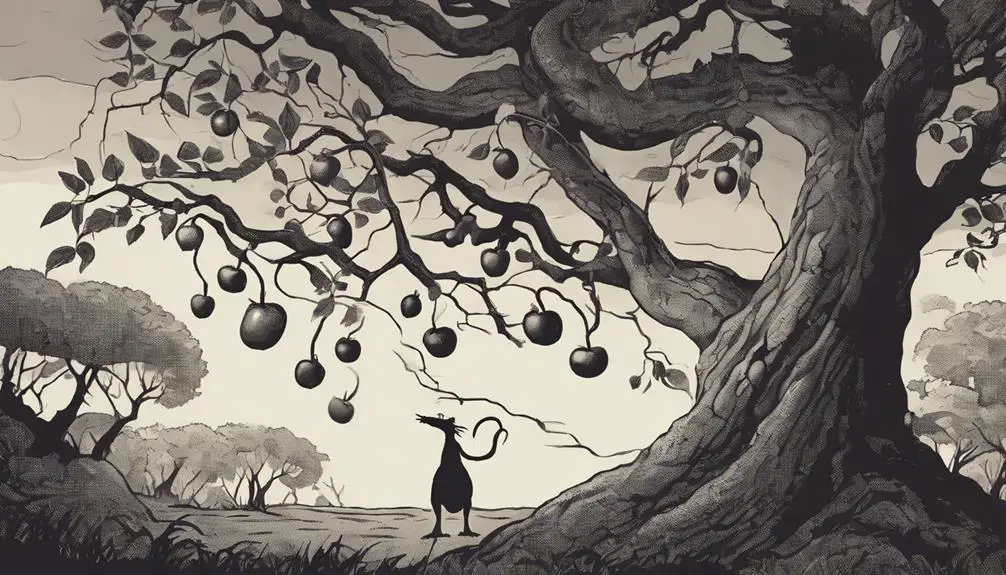Know the serpent's many faces in the Bible, from temptation to wisdom, and uncover the mystery behind its enduring symbolism.

Characteristics of a Serpent in the Bible
Imagine a serpent, coiled and ready, its scales shimmering with a knowledge far beyond human understanding.
In the Bible, you'll find that this creature isn't just a simple reptile; it embodies a complex array of characteristics, from being a symbol of temptation in the Garden of Eden to representing wisdom, healing, punishment, and even heralding the end times.
You might wonder how such a creature can encapsulate so many diverse aspects.
Let's explore these facets together, and perhaps you'll discover that the serpent's role in biblical texts is more intricate and enlightening than you initially thought.
Key Takeaways
- Serpents symbolize both temptation and disobedience, highlighting human vulnerability and moral dilemmas.
- They represent wisdom, showcasing attributes of prudence, insight, and strategic thinking.
- In biblical narratives, serpents are symbols of healing, signifying physical and spiritual restoration.
- Serpents act as agents of divine punishment and are harbingers of End Times, reflecting the complexity of divine judgment and cosmic transformation.
Symbol of Temptation

In the biblical narrative, the serpent emerges as a potent symbol of temptation, fundamentally altering humanity's trajectory by enticing Eve in the Garden of Eden. This pivotal moment underscores the serpent's role as an instigator of moral dilemmas, challenging the innate purity and obedience of human beings. Eve's encounter with the serpent isn't merely a tale of seduction; it's a profound exploration of the complexities inherent in making moral choices. Through this interaction, the serpent introduces the concept of disobedience to divine command, setting a precedent for the eternal struggle between right and wrong that humanity faces.
The serpent's success in persuading Eve to eat the forbidden fruit illuminates its power as a catalyst for ethical conflict. It's this encounter that lays bare the vulnerability of humans to temptation, highlighting the serpent's ability to exploit weaknesses with devastating consequences. This narrative segment serves as a cautionary tale about the susceptibility of individuals to persuasive forces that lead them astray from their moral compasses. As such, the serpent's role transcends that of a mere antagonist; it becomes a symbol of the perpetual moral dilemmas that define the human condition.
Embodiment of Wisdom

Contrary to its role as a symbol of temptation, the serpent also embodies wisdom within the biblical context, offering a multifaceted perspective on its character. This duality underscores the complexity of serpentine metaphors, which ancient interpretations have grappled with, attempting to reconcile its paradoxical nature.
In the wisdom literature of the Bible, the serpent's cunning isn't solely depicted in a negative light but is sometimes regarded as a form of prudence or discernment, worthy of emulation.
For instance, the directive to be 'wise as serpents' underscores the positive attributes associated with serpentine wisdom. This acknowledgment reflects a deeper understanding of wisdom in the biblical sense, not merely as intellectual acuity but as possessing insight, foresight, and the ability to navigate complex situations with discretion. Ancient interpretations often highlight the serpent's ability to discern, adapting its symbolism to convey messages of strategic thinking and careful planning.
Hence, while the serpent's role as a tempter is well-documented, its embodiment of wisdom presents a more nuanced view, suggesting that wisdom, in its truest form, encompasses the capacity to discern between good and evil, making informed choices that reflect both knowledge and understanding.
Sign of Healing

Beyond its associations with temptation and wisdom, the serpent also emerges as a powerful symbol of healing within biblical narratives. This transformation from a creature often seen as malevolent to a sign of restoration and health is profound, reflecting the multifaceted nature of serpent symbolism in ancient texts. In the realm of ancient iconography and medical symbolism, the serpent's role is both literal and metaphorical, bridging the divine with the earthly in acts of healing.
Aspect |
Biblical Reference |
Significance |
|---|---|---|
Bronze Serpent |
Numbers 21:4-9 |
As a divine directive, Moses crafts a serpent of bronze. When looked upon, it becomes a source of healing for the Israelites, bitten by venomous snakes. |
Symbolic Interpretation |
John 3:14-15 |
This event prefigures the crucifixion of Jesus, suggesting salvation and healing through faith. |
Ancient Iconography |
General |
The serpent is a recurring motif in ancient healing symbols, notably in the Rod of Asclepius, which remains a symbol for medicine and healing to this day. |
This nuanced portrayal underscores the serpent's ability to transcend its original sin connotations, embodying the dualistic nature of healing—both as a physical act and a spiritual journey.
Agent of Punishment

While the serpent often symbolizes healing and wisdom in biblical narratives, it also serves as an agent of punishment, illustrating the complexity of its role across sacred texts. This dual symbolism reflects the serpent's capacity to enact divine retribution, a concept deeply intertwined with moral judgement within these narratives. In instances where the serpent is cast as an agent of punishment, it's not merely a passive tool but an active participant in the execution of divine will, embodying the consequences of moral failings.
The serpent's role as a conduit for divine retribution challenges readers to consider the multifaceted nature of justice as depicted in biblical texts. It compels a deeper exploration of how divine justice is meted out, often in ways that transcend human understanding of fairness and retribution. Through this lens, the serpent becomes a symbol not just of temptation and sin, but of the inevitable consequences that follow moral transgressions.
Analyzing the serpent's function as an agent of punishment thus requires a nuanced understanding of biblical themes of justice, divine authority, and moral judgement. It underscores the complexity of the serpent's symbolic roles and invites a reflective examination of the nature of divine retribution within the tapestry of biblical narratives.
Harbinger of End Times

In biblical narratives, the serpent emerges not only as a symbol of sin and punishment but also as a harbinger of the End Times, signifying profound transformations in the cosmic order. This dual role underscores the serpent's complex symbolism within apocalyptic prophecy and eschatological imagery. You'll find that the serpent's association with the End Times is deeply embedded in the fabric of biblical literature, serving as a catalyst for eschatological events and a sign of impending cosmic upheaval.
The serpent's role in eschatological imagery isn't merely decorative; it's integral to understanding the biblical worldview of history's culmination. Through its presence, the serpent conveys the inevitability of transformation and renewal, themes central to apocalyptic prophecy. This symbolism extends beyond the physical creature to encompass the broader forces of chaos and order, encapsulating the struggle between good and evil that characterizes the End Times narrative.
Analyzing the serpent's depiction as a harbinger of the End Times, you're encouraged to contemplate the interplay between symbolic representation and theological message. This perspective reveals the serpent's enduring influence on the development of Christian eschatological thought, highlighting its role in shaping expectations of the cosmic order's ultimate destiny.
Frequently Asked Questions
How Do Different Cultures Outside the Bible View Serpents, and Do These Views Influence Biblical Interpretation?
In exploring serpent mythology, you'll find that cultural perceptions outside the Bible vary greatly. These views significantly influence biblical interpretation, weaving a complex tapestry of meaning.
Serpents are revered in some traditions, symbolizing wisdom and renewal, while in others, they're feared as embodiments of evil. This diversity in interpretation showcases the serpent's multifaceted role across cultures, enriching our understanding of its biblical portrayal through a broader, more nuanced lens.
Are There Specific Biblical Passages That Contradict the Common Representations of Serpents as Evil or Deceptive?
Yes, there are passages that challenge the stereotype of serpents as purely evil or deceptive. When you dive into Genesis analysis, you'll find nuanced interpretations.
For example, Moses' bronze serpent, viewed as a symbol of healing and redemption, offers a form of serpent redemption. This instance suggests a more complex role for serpents, not strictly tied to evil, but also associated with healing and divine intervention, shifting the traditional narrative.
How Has the Symbol of the Serpent Evolved in Christian Art and Literature From the Early Church to Modern Times?
You've seen how the serpent's symbolism has shifted across centuries. In medieval iconography, it often embodied sin or temptation, reflecting prevalent theological views.
Moving into the Renaissance, interpretations diversified, with artists and writers exploring more nuanced meanings, including wisdom and rebirth.
This evolution in Christian art and literature highlights the changing perceptions of symbols, demonstrating how cultural and philosophical shifts impact religious iconography and narratives.
In What Ways Have Contemporary Theologians Reinterpreted the Role of the Serpent in the Bible to Align With Modern Values and Ethics?
You'll find that contemporary theologians have revisited the role of the serpent, integrating environmental symbolism and psychological archetypes into their interpretations. They've shifted away from traditional views, aligning the serpent's image with modern values and ethics.
This reevaluation emphasizes the serpent's connection to wisdom, transformation, and the natural world, offering a more nuanced perspective that resonates with today's environmental and psychological understanding. It's a fascinating blend of ancient text and contemporary insight.
How Do Serpent Symbols in the Bible Compare With Serpent Worship or Reverence in Other Ancient Religions?
When you examine serpent iconography across ancient religions, you'll find fascinating mythological parallels. Unlike the Bible, where serpents often symbolize temptation or evil, other traditions might revere them as symbols of wisdom, fertility, or even immortality.
This comparison highlights how cultural contexts deeply influence religious symbols' interpretations. It's intriguing to explore how different societies have either worshipped or vilified serpents, reflecting diverse spiritual and moral landscapes.
Conclusion
In analyzing the biblical serpent, it's evident that this figure is multifaceted, symbolizing temptation, embodying wisdom, acting as a sign of healing, serving as an agent of punishment, and heralding the end times.
Your exploration reveals the serpent's complex role within biblical narratives, illustrating its capacity to convey diverse theological and moral lessons.
This nuanced portrayal underscores the serpent's significance in biblical literature, inviting a deeper reflection on its symbolic implications across various contexts and teachings.



Sign up